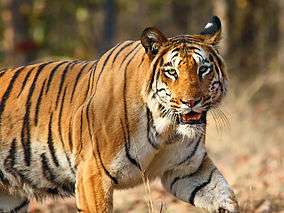Northern Ridge biodiversity park
Northern Ridge biodiversity park,[2] in Delhi Ridge of Aravalli range is a 87 hectares biodiversity area in the Northern Ridge (also called Kamla Nehru Ridge or forest) in Delhi, India.[3][4][5][1] It lies in the Northern Aravalli leopard wildlife corridor.
| Northern Ridge biodiversity park | |
|---|---|
| Type | Natural Area |
| Location | North ridge, Delhi Ridge, Delhi |
| Nearest city | Delhi University |
| Coordinates | 28.6803217°N 77.2065972°E |
| Area | 87 hectares[1] |
| Created | 2015 |
| Operated by | Delhi Development Authority |
| Status | Open |
History
| Part of a series on the |
| Wildlife of India |
|---|
 |
|
Biodiversity
|
|
|
|
Organisations
Ministry of Environment
and Forests
World Society for the
Protection of Animals (WSPA) |
Delhi has more than 7,884 hectares of fragmented forests, which are deprived of wild animals due to the unplanned urbanisation. Of the over 400 wetlands of Delhi, fewer than 3 or 4 major ones existed in 2014. In 2015, Delhi already had Aravalli Biodiversity Park and Yamuna Biodiversity Park. Delhi Development Authority (DDA) engaged the scientists of Delhi University to develop four more biodiversity parks in Delhi, including the Northern ridge biodiversity park (Kamla Nehru Ridge), Tilpath valley biodiversity park, Neelahauz biodiversity park and phase-2 of the Yamuna Biodiversity Park.[5]
Restoration
It was restored in 2014–16 on 87 hectares of Kamla Nehru Ridge (also called Northern Ridge) near Delhi University.[1][6] The ridge was infested with the invasive species of prosopis juliflora (Vilayati Babul or Kikar of Mexican origin), which were planted in the 1920s by the Britisher colonisers to rehabilitate the wasteland. Prosopis juliflora has caused the depletion of the water table due to its 15-m-deep root system, resulting in the death of 450 native species as well as the biodegradation of the flora and fauna. With the view to reintroduce 5,000 native plant species which existed 150 years ago in the ridge, the Vilayati Kikar was replaced with 15 native plant species in 2014.[7] Additional 3-layered native plant species are being planted.[6]
Flora
Some of the native species being replanted at several Delhi ridges to replace the invasive Vilayati Kikar include mahua, haldu, sheesham, bael, other shrubs and grasses.[7][8]
Fauna
Several ridges of Delhi are being restored to revive the native species including leopard, Indian rock python, jackals, neelgai, mongooses, porcupines, small Indian civet, gecko, Sirkeer malkoha cuckoo, nightjar, Indian paradise flycatcher.[7][8]
See also
- Delhi Ridge
- National Parks & Wildlife Sanctuaries of Haryana
References
- DDA biodiversity parks.
- "Restoring Delhis environment". The Financial Express. India: The Financial Express. 25 December 2013. Retrieved 18 January 2019.
- "Tadas Shri Ramdas Chandrabhanji". loksabha.nic.in. India: Lok Sabha, Government of India. Retrieved 18 January 2019.
- April 19, Press Trust of India; April 19, 2017UPDATED; Ist, 2017 21:50. "L-G suggests creation of green circuit to connect city parks". India Today. India: India Today. Retrieved 18 January 2019.CS1 maint: numeric names: authors list (link)
- Scientists engaged develop four biodiversity parks, Deccan Herald, 23 August 2015.
- Government takes steps to restore biodiversity of Kamala Nehru ridge, Mellinium Post, 14 Oct 2014.
- Two years on, Tilpath Valley Biodiversity Park breathes again, Times of India, 23 Feb 2018.
- Delhi gets its third biodiversity park in Tilpat Valley, Hindustan Times, 3 Feb 2018.